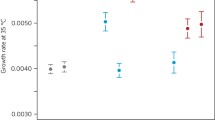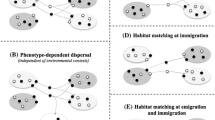Abstract
Gene flow is often regarded a random process that homogenizes differences between populations and constrains local adaptation. However, the matching habitat choice hypothesis posits that individuals actively choose those microhabitats that best match their specific phenotype to maximize fitness. Dispersal (and possibly gene flow) may thus be directed. Many studies report associations between habitats and phenotypes, but they may reflect selection, plasticity or adaptation rather than matching choice. Here, we test two predictions from the matching habitat choice hypothesis by manipulating the dorsal colour of Tetrix subulata, a pygmy grasshopper. (1) Is microhabitat choice flexible such that differently manipulated phenotypes distribute themselves differently in a microclimatic and solar radiation mosaic? (2) If they do, are their fitness prospects higher in the more preferred microhabitat? We find that individuals painted white or black do distribute themselves differently, with black individuals residing in habitats with less radiation, on average, than white individuals, demonstrating that microhabitat choices are plastic. Furthermore, white females had more hatchlings than black ones in the increased radiation treatment, and this was mainly due to increased mortality of black females under increased radiation. These findings provide rare experimental evidence in line with predictions from the matching habitat choice hypothesis.



Similar content being viewed by others
References
Ahnesjö J, Forsman A (2003) Correlated evolution of colour pattern and body size in polymorphic pygmy grasshoppers, Tetrix undulata. J Evol Biol 16:1308–1318
Ahnesjö J, Forsman A (2006) Differential habitat selection by pygmy grasshopper color morphs; interactive effects of temperature and predator avoidance. Evol Ecol 20:235–257
Anthony CD, Venesky MD, Hickerson CAM (2008) Ecological separation in a polymorphic terrestrial salamander. J Anim Ecol 77:646–653
Armsworth PR (2009) Conditional dispersal, clines, and the evolution of dispersiveness. Theoretical Ecol 2:105–117
Armsworth PR, Roughgarden JE (2005) The impact of directed versus random movement on population dynamics and biodiversity patterns. Am Nat 165:449–465
Armsworth PR, Roughgarden JE (2008) The structure of clines with fitness-dependent dispersal. Am Nat 172:648–657
Arnold SJ, Pfrender ME, Jones AG (2001) The adaptive landscape as a conceptual bridge between micro- and macroevolution. Genetica 112:9–32
Bolnick DI, Snowberg LK, Patenia C, Stutz WE, Ingram T, Lau OL (2009) Phenotype-dependent native habitat preference facilitates divergence between parapatric lake and stream stickleback. Evolution 63:2004–2016
Caesar S, Forsman A (2009) Do polyandrous pygmy grasshopper females obtain fitness benefits for their offspring? Behav Ecol 20:354–361
Caesar S, Karlsson M, Forsman A (2010) Diversity and relatedness enhance survival in colour polymorphic grasshoppers. PLoS One 5:e10880
Cluttonbrock TH (1984) Reproductive effort and terminal investment in iteroparous animals. Am Nat 123:212–229
Edelaar P, Siepielski AM, Clobert J (2008) Matching habitat choice causes directed gene flow: a neglected dimension in evolution and ecology. Evolution 62:2462–2472
Ford EB (1945) Polymorphism. Biol Rev Cambridge Philoso Soc 20:73–88
Forsman A (1997) Thermal capacity of different colour morphs in the pygmy grasshopper Tetrix subulata. Ann Zool Fenn 34:145–149
Forsman A (1999a) Reproductive life history variation among colour morphs of the pygmy grasshopper Tetrix subulata. Biol J Linn Soc 67:247–261
Forsman A (1999b) Variation in thermal sensitivity of performance among colour morphs of a pygmy grasshopper. J Evol Biol 12:869–878
Forsman A (2000) Some like it hot: intra-population variation in behavioral thermoregulation in color-polymorphic pygmy grasshoppers. Evol Ecol 14:25–38
Forsman A (2001) Clutch size versus clutch interval: life history strategies in the colour-polymorphic pygmy grasshopper Tetrix subulata. Oecologia 129:357–366
Forsman A, Appelqvist S (1998) Visual predators impose correlational selection on prey color pattern and behavior. Behav Ecol 9:409–413
Forsman A, Appelqvist S (1999) Experimental manipulation reveals differential effects of colour pattern on survival in male and female pygmy grasshoppers. J Evol Biol 12:391–401
Forsman A, Ringblom K, Civantos E, Ahnesjö J (2002) Coevolution of color pattern and thermoregulatory behavior in polymorphic pygmy grasshoppers Tetrix undulata. Evolution 56:349–360
Forsman A, Ahnesjo J, Caesar S (2007) Fitness benefits of diverse offspring in pygmy grasshoppers. Evol Ecol Res 9:1305–1318
Forsman A, Karlsson M, Wennersten L, Johansson J, Karpestam E (2011) Rapid evolution of fire melanism in replicated populations of pygmy grasshoppers. Evolution 65:2530–2540
Garant D, Kruuk LEB, Wilkin TA, Mccleery RH, Sheldon BC (2005) Evolution driven by differential dispersal within a wild bird population. Nature 433:60–65
Gillis JE (1982) Substrate color-matching cues in the cryptic grasshopper Circotettix rabula rabula (Rehn and Hebard). Anim Behav 30:113–116
Hochkirch A, Deppermann J, Gröning J (2008) Phenotypic plasticity in insects: the effects of substrate color on the coloration of two ground-hopper species. Evolut Development 10:350–359
Holt RD, Barfield M (2008) Habitat selection and niche conservatism. Israel J Ecol Evolut 54:295–309
Hosmer DW, Lemeshow S, May S (2008) Applied survival analysis: regression modeling of time-to-event data, 2nd edn. Wiley, Hoboken
Jaenike J, Holt RD (1991) Genetic-variation for habitat preference—evidence and explanations. Am Nat 137:S67–S90
Jones JS (1982) Genetic-differences in individual behavior associated with shell polymorphism in the snail Cepaea nemoralis. Nature 298:749–750
Karlsson M, Forsman A (2010) Is melanism in pygmy grasshoppers induced by crowding? Evol Ecol 24:975–983
Karlsson M, Caesar S, Ahnesjo J, Forsman A (2008) Dynamics of colour polymorphism in a changing environment: fire melanism and then what? Oecologia 154:715–724
Karlsson M, Johansson J, Caesar S, Forsman A (2009) No evidence for developmental plasticity of color patterns in response to rearing substrate in pygmy grasshoppers. Can J Zool 87:1044–1051
Lande R, Arnold SJ (1983) The measurement of selection on correlated characters. Evolution 37:1210–1226
Littell RC, Milliken GA, Stroup WW, Wolfinger RD, Schabenberger O (2006) SAS for mixed models, 2nd edn. SAS Institute Inc., Cary
Mayr E (1963) Animal species and evolution. Harvard University press, Cambridge
Mckinnon JS, Pierotti MER (2010) Colour polymorphism and correlated characters: genetic mechanisms and evolution. Mol Ecol 19:5101–5125
Morey SR (1990) Microhabitat selection and predation in the pacific treefrog, Pseudacris-regilla. J Herpetol 24:292–296
Nabours RK (1929) The genetics of Tettigidae. In: Bibliographica Genetica. Verlag M Nijhoff, den Haag, Netherlands, pp 27–104
Nosil P, Sandoval CP (2008) Ecological niche dimensionality and the evolutionary diversification of stick insects. PLoS ONE 3(4):e1907
Nosil P, Sandoval CP, Crespi BJ (2006) The evolution of host preference in allopatric vs. parapatric populations of Timema cristinae walking-sticks. J Evol Biol 19:929–942
O’Brien RG, Kaiser MK (1985) MANOVA method for analyzing repeated measures designs—an extensive primer. Psychol Bull 97:316–333
Ohgushi T (1996) A reproductive tradeoff in an herbivorous lady beetle: egg resorption and female survival. Oecologia 106:345–351
Olson EC, Miller RL (1958) Morphological integration. University of Chicago Press, Chicago
Pigliucci M, Preston K (2004) Phenotypic integration: studying the ecology and evolution of complex phenotypes. Oxford University Press, Oxford
Räsänen K, Hendry AP (2008) Disentangling interactions between adaptive divergence and gene flow when ecology drives diversification. Ecol Lett 11:624–636
SAS (1999) SAS OnlineDoc Version 8. SAS Institute Inc, Cary, NC, USA
SAS (2004) SAS/STAT 9 1. In. SAS Institute Inc, Cary
Shine R, Ambariyanto, Harlow PS, Mumpuni (1998) Ecological divergence among sympatric colour morphs in blood pythons, Python brongersmai. Oecologia 116:113–119
Sinervo B, Svensson EI (2002) Correlational selection and the evolution of genomic architecture. Heredity 89:329–338
Smith TB, Skulason S (1996) Evolutionary significance of resource polymorphisms in fishes, amphibians, and birds. Ann Rev Ecol Syst 27:111–133
Stillwell RC, Davidowitz G (2010) Sex differences in phenotypic plasticity of a mechanism that controls body size: implications for sexual size dimorphism. Proceedings Royal Soc B-Biol Sci 277:3819–3826
True JR (2003) Insect melanism: the molecules matter. Trends Ecol Evol 18:640–647
Wright S (1934) The method of path coefficients. Annals Math Stat 5:161–215
Acknowledgments
We thank P Tibblin, H Berggren, J Eriksson and J Johansson for assistance in the field and laboratory, P Edelaar for discussion during planning of this work, B. Karpestam for assistance with graphs and two anonymous reviewers for comments on an earlier version of the manuscript. The study was supported by The Swedish Research Council, The Swedish Research Council Formas (grants to A.F.), and Linnaeus University.
Author information
Authors and Affiliations
Corresponding author
Rights and permissions
About this article
Cite this article
Karpestam, E., Wennersten, L. & Forsman, A. Matching habitat choice by experimentally mismatched phenotypes. Evol Ecol 26, 893–907 (2012). https://doi.org/10.1007/s10682-011-9530-6
Received:
Accepted:
Published:
Issue Date:
DOI: https://doi.org/10.1007/s10682-011-9530-6




